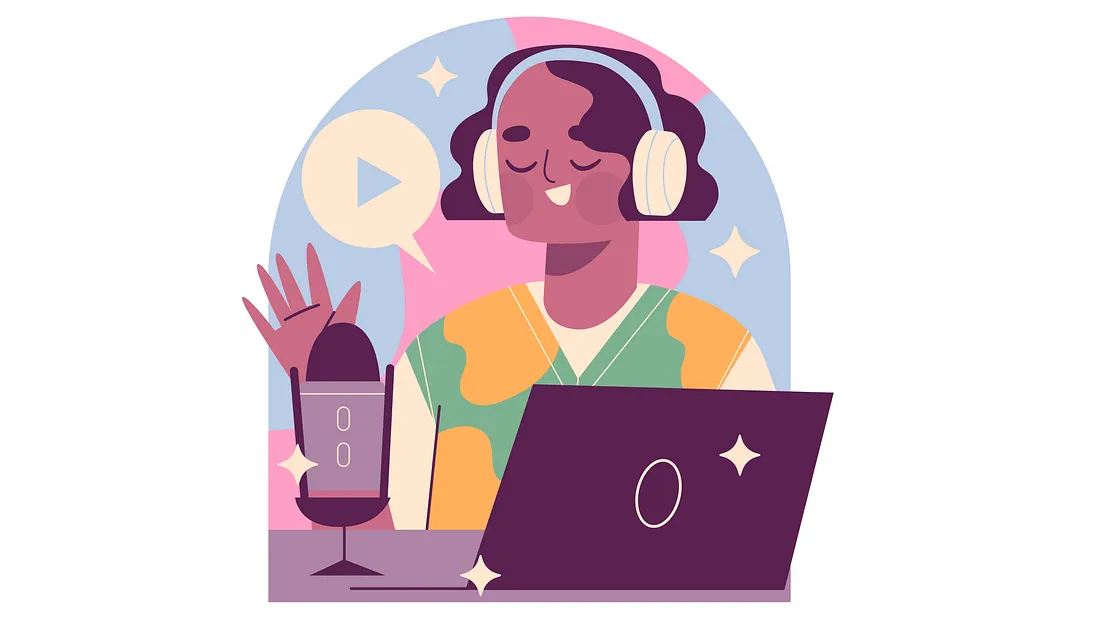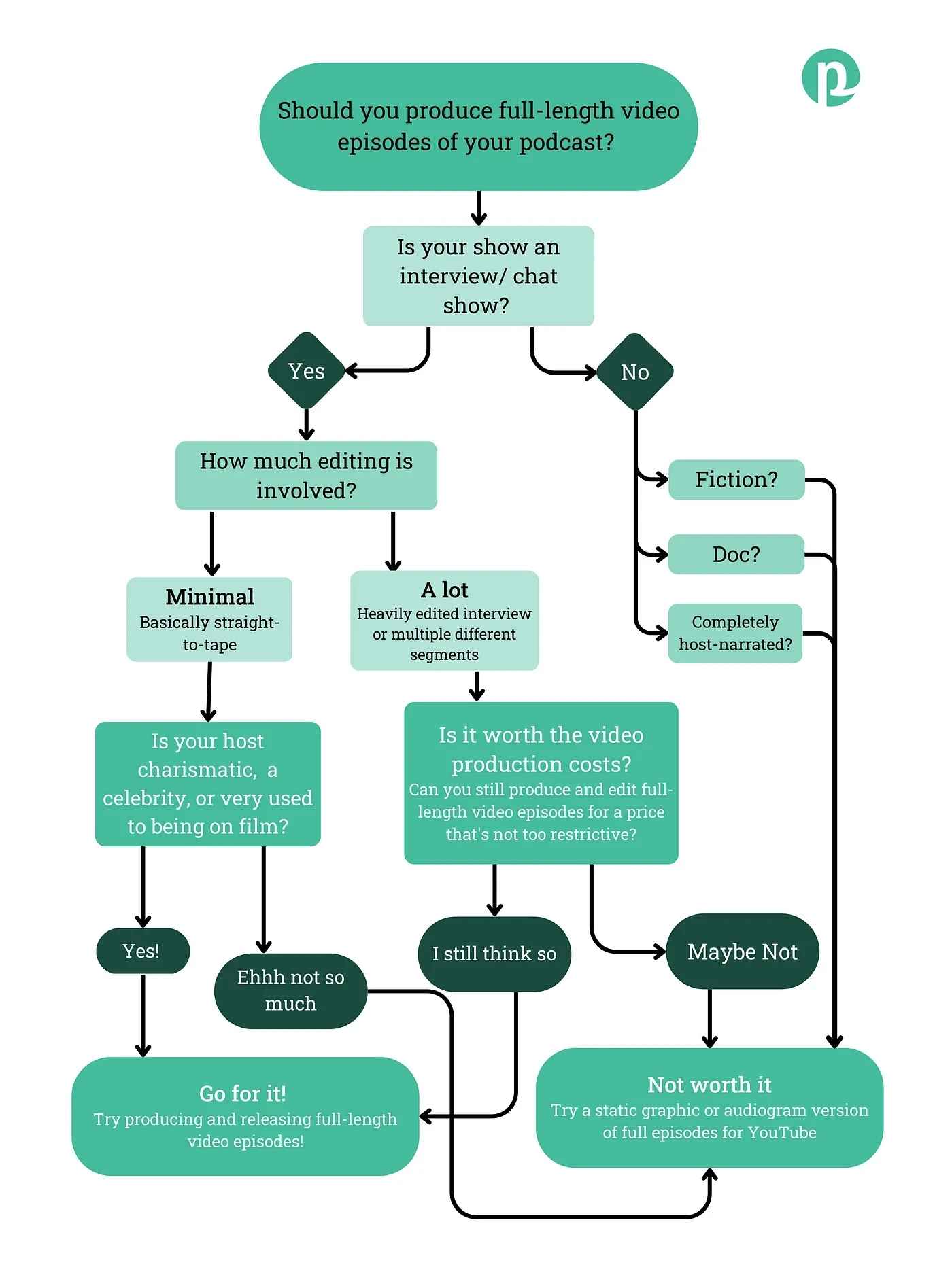The Ultimate Guide to Your Brand’s Video Podcast Strategy

Everyone in the podcast world still can’t stop talking about video. Even in the branded podcast world, I’ve been asked countless times, “What’s your video strategy?” or, “What’s your recommendation for how we should be using video?” But the truth is that when it comes to video podcasts, there isn’t one single strategy that will work for every brand or for every podcast.
So, based on our experience with video and what I’ve been hearing in the industry, I’ve created a couple flow charts to help you determine your podcast’s video strategy.

If your podcast isn’t a simple chat or interview style podcast, it’s probably not going to be worth the work and money it would take to turn your full-length episodes into videos. Even if your show IS a chat show AND you typically keep edits minimal, you still need a host and guests that are charismatic and comfortable with being on camera to make it worth it to record full-length video versions of each episode. Otherwise, you’re spending a lot of time and money on a product that most people won’t want to watch (or worse — that could actually damage your brand’s reputation for quality).
In general, we know that lots of people are consuming podcasts on YouTube. But out of those who click play, how many are actually watching the entirety of those long-form episodes on YouTube? For most branded podcasts, producing full-length versions of each episode is unlikely to pay off in deeper engagement, stronger brand lift, or more listeners.
That doesn’t mean your podcast shouldn’t have a presence on YouTube. You can still publish full-length episodes with static images or audiograms (a much smaller production lift). This will increase discoverability (search on YouTube far outperforms most podcast players), it provides a visual graphic to offer more context for the episode (i.e. an image of the guest or an archival photo), and listeners can minimize the screen while they perform other activities. Don’t forget, one of the things that makes podcasts so powerful is the ability for consumers to go off-screen while still engaging with content. If your podcast requires consumers to both watch and listen to entire episodes, you could be spending all that time and money just to reduce your chances of keeping audience attention.
But what about short-form videos?
Even if it doesn’t make sense to produce full-length video versions of your podcast episodes, you still might want to consider a short-form video strategy. But again, there isn’t a one-size-fits-all short-form video strategy that works for every brand’s podcast.

Before developing your short-form strategy, consider: Are you looking to grow your podcast audience? Or are you looking for opportunities to repurpose your podcast’s research, stories, or charismatic host across other platforms?
If you’re looking to grow your podcast audience…
As we’ve said time and again on this blog, it’s very hard to convert social media scrollers into podcast listeners. So, if your goal is purely to grow your podcast audience, creating video content for social media may not be worth the cost. But if you’re still really set on giving it a try with short-form video content, consider using YouTube Shorts. This will help with discoverability, plus listeners can move more seamlessly to full episodes within the YouTube app.
If you’re looking to repurpose your podcast content…
There is so much research, story editing and guest chase that goes into producing a successful podcast. It makes so much sense to repurpose all of that work and share the stories, guests and research from your podcast across your social media platforms. It’s a cost-effective way to generate more content for your social pipeline, and it allows you to reach non-podcast listeners with bitesized versions of the same stories you’ve told on your show.
The type of short-form videos you produce will depend on the goals of your brand’s podcast and the format of your show. If you’re working with a charismatic host and you’re looking to associate your brand with high-level guests, it might make a lot of sense to record video versions of your interviews and cut just the most interesting parts for use on social. The Problem With Jon Stewart has experimented with this on YouTube Shorts.
If your brand is focused on telling stories that demonstrate your values or associate you with certain topics, you might not need to record any video of your host or guests at all. You could clip an interesting short audio clip from your episode and add other visuals overtop for social.
For example, if you’re telling a historical story, you could try editing archival photos or videos over a clip from the episode. Our client Atlassian was able to effectively do this with their latest season of Teamistry, which told the story of Concorde and supersonic flight. (Medium won’t let me embed Instagram reels, so check it out here).
If your goal is to associate your brand with a superstar host (or turn your CEO into a superstar), you could even have the host record a short video speaking to the camera summarizing a short story or interesting takeaway from the podcast episode. Follow this up with a call-to-action for people to check out the podcast episode to learn more. This type of content will feel completely native to TikTok or Reels, it will solidify your brand’s association with that host, and you have the added benefit of hopefully recruiting your host’s social followers as new listeners of your show. An example of this is @itsbecomeawholething on TikTok.
Yes, this is a celebrity gossip podcast. And yes, it is my guilty pleasure. Emily Rose uses stories and research from her latest episodes to create these short-form videos that feel very in-line with her regular TikTok content, so viewers aren’t likely to scroll past. But her CTA to check out her podcast is incredibly effective. If you’re willing to stay till the end of the video, you’re likely going to be interested in learning more about the story by listening to her podcast. (And yes, it did work on me).
Ultimately, there is no one-size-fits-all video strategy for branded podcasts. It’s important to consider the goals of your podcast and your brand when determining your podcast video strategy.
Sign up for the Pacific Content Newsletter: audio strategy, analysis, and insight in your inbox.
